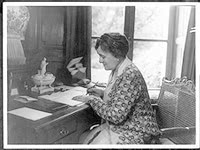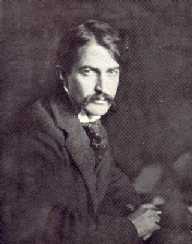The Adaptation of Genre and Suppression of the Supernatural in Edith Wharton and Stephen Crane
It is important to keep in mind that while it was once thought that genres were air-tight categories that reflected some natural and stable pattern into which literature could be placed and identified, it is now more common to see genres as somewhat stable, but nevertheless changing, descriptive devices that help us note the "family resemblances" between various works and approaches. Genres are fuzzy in that they can be adapted and reworked, even redefined, but they nonetheless have a history made up of periods of general consensus. The notion of the epic, for example, changes over the centuries in the Western tradition. Virgil builds on Homer. Milton builds on Virgil. Of course, such a pattern can be altered in radical ways. Indeed, by the time the epic reaches works like Wordsworth's The Prelude or James Joyce's Ulysses it seems to have left the form and stable categories of Homer, Virgil, and Milton far behind, yet these later definitions of the epic can not exist without past notions that they build off of and modify.


Genres, because they are semi-stable and reflect an evolving consensus, also represent definitions of the moral, social, and physical world. A genre implies something about how the world is understood. Clint Eastwood's Unforgiven, for example, works to undercut assumptions in the films of John Wayne. He wishes to show us that the western is about moral nihilism rather than rugged individualism and personal justice. To do this however, he must begin with an audience's expectations about the moral world of the western.
Plausibility structures: the reigning, commonly received notions about reality. Plausibility structures are what the majority of people believe to be so true as not to be generally questioned. They tend to be reinforced by the large-scale political, scientific, and academic communities and play a large part in the worldview of mass media. They determine what we consider reasonable and responsible action.
For example, Lesslie Newbigin points out that in the modern West, naturalism is the reigning plausibility structure. It is simply not questioned by most people. Such a structure assumes the absence of an large-scale, divine telos, end, purpose, or direction, for human life and culture. It also assumes that ethics are functional; they are not dogma and canon. Instead, codes of behavior are created to achieve certain ends, but those codes have no basis in anything other than widespread consensus and convenience.
Genres and plausibility structures share a common pattern. Robert Stam has suggested that genres have four ways of reinforcing their claims:
- They practice extension: they draw borders that determine what is in a genre and what is not.
- They supply normativeness: they establish which works provide norms and are thus at the center of a genre and which works are abnormal and on the outskirts of the genre.
- They create an illusion of monolithism: they tempt us to place a work in only one genre, as if it couldn't belong to several.
- They suggest a biologism: they act as if genres were creatures developing through a life cycle of birth-growth-decline-death. This treats a genre as something ontological, as being essentially itself and nothing else.
Note that plausibility structures do the same thing:
- Plausibility structures tell us how we can define matters like love, power, freedom, and reality. Naturalism, for example, defines reality as materialistic. The metaphysical and spiritual are then not real or plausible.
- Plausibility structures suggest what behavior should be considered responsible. Naturalism decides that normal behavior is essentially evolutionary and behavioral. Prayer is non-normative behavior.
- Plausibility structures keep us from considering new definitions of something. For example, many reduce the scientific method to one that must function without a theistic principle. To suggest otherwise is to call into question the monolithic definition.
- Plausibility structures tell us what something is, what its essence is. To use a counter-example to the ones above, Christians define a church as a spiritual community of followers of Jesus gathered together in a temporal setting. Someone else might tell us that they are actually social units designed to perpetuate close-minded thinking.
Wharton's "The Eyes" and Crane's "The Blue Hotel" both act to alter and perhaps critique a particular genre -- Wharton, the ghost story, and Crane, the dime-store western. While Crane is seeking to change the plausibility structure from that of the heroic to naturalistic evolution, Wharton is more interested in the unclear gap between the supernatural and the psychological. In either sense, to change the plausibility structure, you must also change the genre.
Questions for Wharton's "The Eyes"
"The celebrated reply [. . .] ‘No, I don’t believe in ghosts, but I’m afraid of them’ is much more than a cheap paradox it seems to many [. . .] The ghost may after all succumb first to the impossibility of finding standing room in a roaring and discontinuous universe."
--Edith Wharton
The nineteenth-century ghost story had its origins in the turn-of-the-century gothic novels of William Beckford and Anne Radcliffe as well as turns by Sir Walter Scott and Charles Dickens. The newer genre of the ghost story published in magazines, practiced by authors such as M.R. James, Oliver Onions, and H. Russell Wakefield, tended to stress traditional English countryside manors haunted by marauding ghosts. Like its gothic predecessors, the nineteenth-century ghost story focused on building a sense of foreboding and nameless terror. As a genre, it depended on a feeling for the terrifying side of the supernatural.
- How does Wharton's story invoke the ghost story yet also work to distance itself from it? Does she want to have her cake and eat it too? Is she seeking to suppress the spiritual? From what does the story derive its particular power?
- What is Culwin's view of humanity? (692) Is there a relationship between his positivism and his sense of detachment?
- What is Culwin's attitude towards Frenham? towards Alice? towards Noyes? On what basis does he judge the personal costs of his relationship to them?
- How does Culwin describe the eyes he sees? Why do they turn out to be his own?
- Why does Culwin focus on physical description when he discusses his reaction to the eyes?
- What role does the parasitic (e.g. the vampire) play in the story?
- What do you make of Frenham's end (death?)? Has Culwin invoked forces he cannot control?
Questions for Crane's "The Blue Hotel"
"We tell kids that heaven is just across the gaping grave and all that bosh and then we scare them to glue with flowers and white sheets and hymns. We ought to be crucified for it! . . . I have forgotten nothing about this, not a damned iota, not a shred."
-- Stephen Crane, Letter 790
The dime-store Western, misguided perhaps as it was in its uncritical appropriation of the cowboy mythos and its demonization of Native Americans, nonetheless operated on certain ethical sets of assumptions about justice and vengeance, in part based on such cultural mythmakers as Wild Bill Hickcock and his "Wild West Rocky Mountain and Prairie Exhibition" stage shows, ones complete with the salvation of the innocent prairie family. Building in part on older notions of American character from works like those of James Fenimore Cooper, the nineteenth-century dime store novel began in 1869 with works by Ned Buntline. Prentiss Ingram’s novels, which he began shortly thereafter, included earnest, moralistic titles like Adventures of Buffalo Bill from Boyhood to Manhood. Deeds of Daring and Romantic Incidents in the Life of William F. Cody, the Monarch of the Bordermen. Other famous songs, such as "Home on the Range" with lyrics like "Out where the handclasp’s a little stronger/ Out where the smile dwells a little longer" and Harper’s Weekly’s publication of Western images by Frederick Remington in 1886 also contributed to this particular understanding of the cowboy as virtuous if somewhat individualistic . The dime-store novel was a violent world but one with understandable universals in place.
- How does Crane's story seek to undercut the dime-store western? What assumptions on the part of his audience is he seeking to challenge?
- What effect does the typical genre have on the thinking of the Swede?
- How would you describe the following characters: Scully, the Swede, Johnnie, Bill the cowboy, the Easterner?
- What does the Eastern mean by concluding that "[t]he entire prelude had in it a tragedy greater than the tragedy of action"? (779) What does this suggest about the men's relationship to the natural world?
- What is Crane's view of humanity? cf. 783 "One viewed the existence of man then as a marvel, and conceded a glamour of wonder to these lice which were caused to cling to a whirling, fire-smote, ice-locked, disease-stricken, space-lost bulb. The conceit of man was explained by this storm to be the very engine of life. One was a coxcomb not to die in it." Is his view entirely negative? Is it entirely naturalistic?
- Why is it significant that "a human body, this citadel of virtue, wisdom, power, was pierced as easily as if it had been a melon"? (786)
- What is the meaning of the final speech of the Easterner? Why is a murder "a culmination, the apex of a human movement" (787)?
- As an experiment in alternative imaginations, consider how different Crane's story would be if either it were a traditional western and/or if it assumed a spiritual reality. What would it look like?
